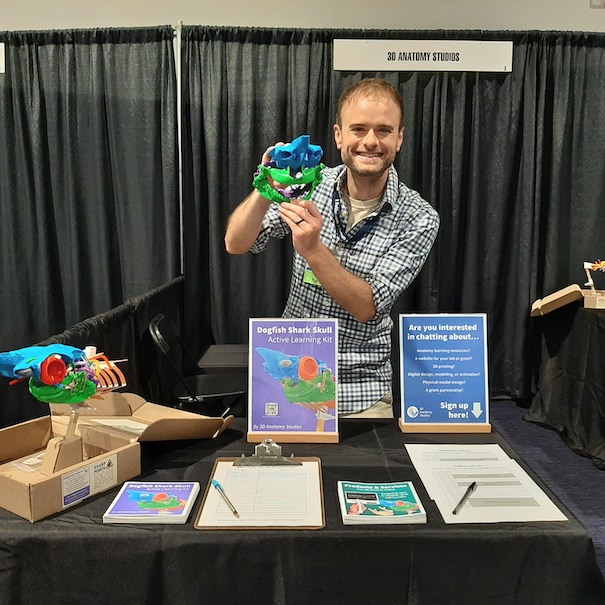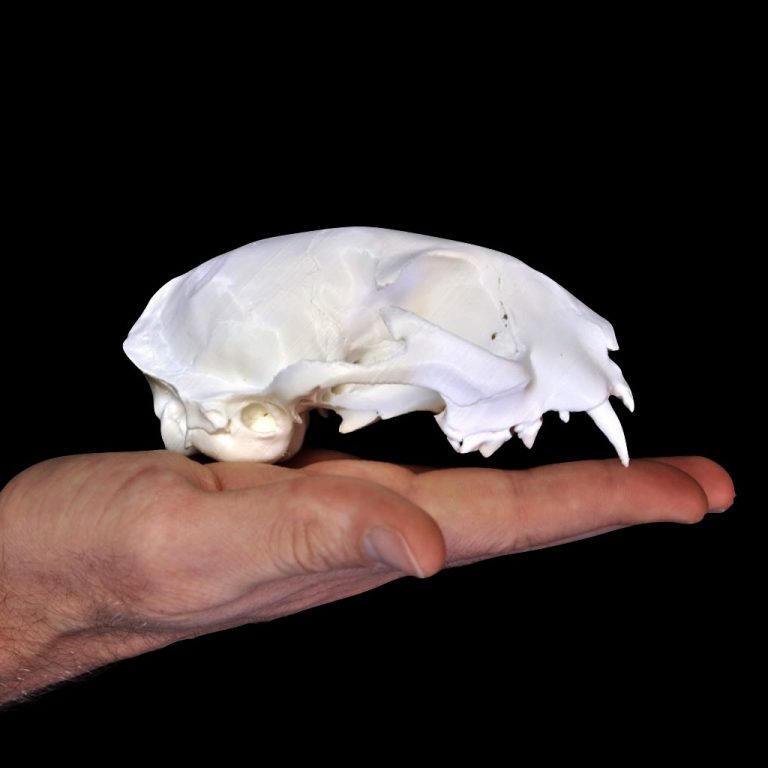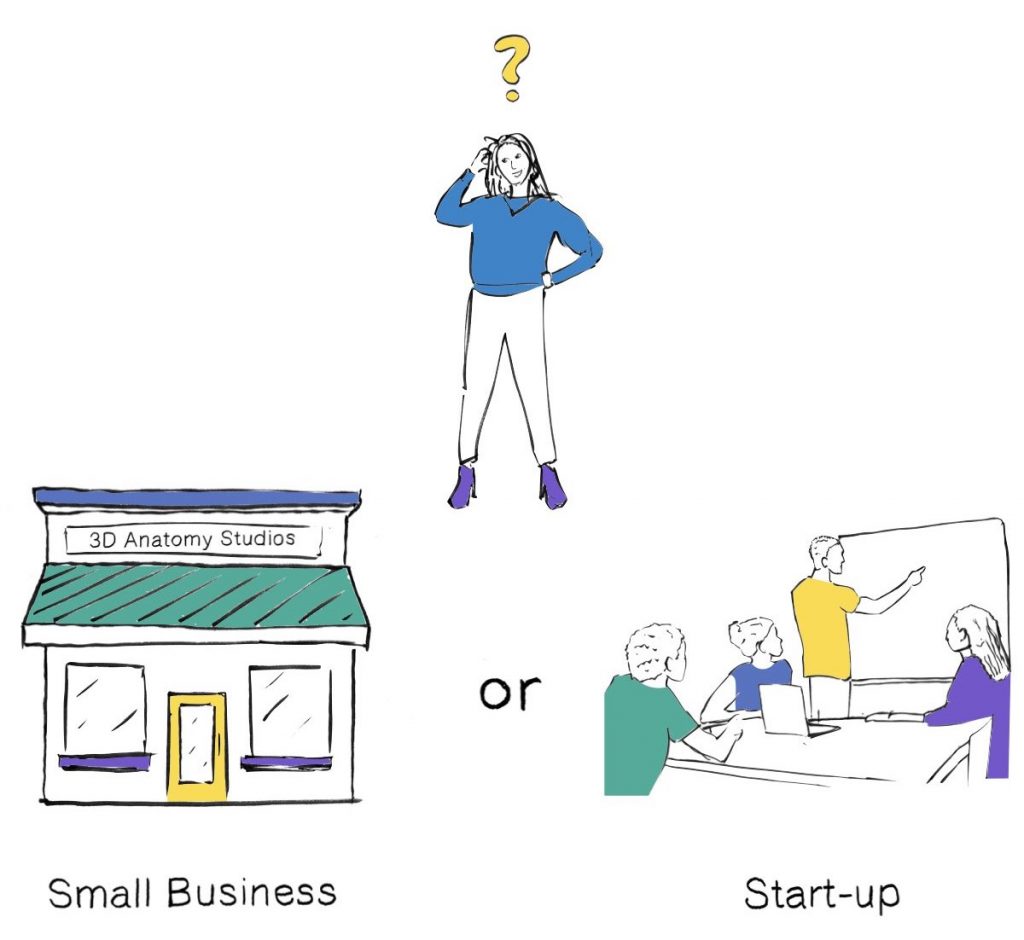
In starting and now running 3D Anatomy Studios, one of the most common questions that we get asked is some variation on “What do you do?” They might ask “What products do you sell?”, “What services do you provide?”, or “What are you working on?” but the basic question is the same. They’re really asking us who or what we are as a business.
In this monthly update post, I’ll explain how 3D Anatomy Studios currently operates partly as a small business and partly as a start-up, providing project-specific and expert-driven services while also innovating new scalable products, all within the scope of organismal biology research, education, outreach, and design. But before that, I want to explain the typical differences between “small business” and “start-up” why they’re better thought of as two extremes along a continuum rather than entirely discrete categories.
Small business or start-up? There’s not always a clear distinction
When you’re starting a business and people ask “what do you do?”, they’re making an assumption that in starting that business, you have already identified your business model. For those not familiar with the term “business model,” it refers to the fundamental concept of the business: what do you do for others and what do they give you in return? It’s a perfectly reasonable question and many new small businesses can answer that question with a simple, one-sentence response, such as: “we’re a coffee shop,” “we do air conditioning installation and repair,” or “we make artisanal cheeses.”
These seemingly simple phrases actually communicate really complex concepts. But people understand those complex concepts immediately because they are established business models (e.g., “artisanal cheesemaking” is a model that has existed for several centuries or more!) and they are business models that most people interact with at some point in their life, sometimes on a daily basis. But what if you’re starting a business that isn’t based on an established business model? What if you don’t have one of those simple phrases that immediately communicates to others “what you do”? What if you’re trying out one or several untested business models?
In the world of entrepreneurship, “small businesses” and “start-ups” often occupy entirely independent spaces. Funding streams are separate, professional associations and networking events are separate, the support and mentoring services are separate, etc. One of the main distinctions between the two is that a small business operates according to an established business model whereas a start-up is testing out a new business model. A local coffee shop is an example of an established small business model. For the purposes of this post, let’s Imagine a fictitious shop called “Java House.” Java House buys roasted coffee beans and pastries and rents a commercial space; they then sell brewed coffee and pastries while also providing a space for customers to sit, gather, and work.
An example of a start-up, sticking with the coffee theme, would be a business that makes coffee-scented caffeine skin patches – a fictitious example, as far as I know! We’ll call this fictitious start-up “Java Patch.” Java Patch has stripped away most of the traditional coffee shop business model elements (e.g., retail location, indoor seating, liquid coffee) and is testing a new model where people pay for continuous, low-dose caffeine delivery through a skin patch with a pleasant, fresh brewed coffee aroma. But would people actually buy a “java patch”? To test this, Java Patch interviews many potential customers to learn about how they experience coffee, their caffeine use, their morning routine, a process known as customer discovery (more about this later). And Java Patch will likely change their business model, or “pivot,” many times throughout this process as they gather data.
A second difference between a typical small business and start-up is scalability. A local coffee shop can’t easily scale up their product or service. Each cup of coffee is individually brewed and customized according to each customer’s order. If you want a double shot medium latte with soy milk and caramel syrup, Java House will make it for you! But you may pay $5 or more for that cup of coffee, to cover the cost of providing such a personalized service. In contrast, once Java Patch knows that their business model is viable and they can manufacture their product safely, they can create millions of patches and sell them for $0.50 to $1 each. You pay less as a customer, but at scale there’s no longer any personalized service.
Another difference between a typical small business and start-up is how “fully” they operate as a business. When someone starts a small business, they typically intend to continue operating that business for many years, perhaps even passing it on to a future generation. In contrast, a start-up is intended to be temporary. The goal is to develop a business model with enough potential that they can sell the start-up to a larger business (called an “exit”). For this reason, a small business typically performs all the normal operations of a business (e.g., marketing, sales, customer service, hiring) whereas a start-up may never actually interact with paying customers, focusing instead on raising investor capital for R&D and then rewarding investors with a return when the start-up is sold.
At this point, you’re probably seeing how a small business or a start-up may want to borrow certain aspects from each other, depending on their objective. For example, what if Java House wanted to experiment a bit with their business model by creating temporary “coffee gardens” around their town? Their idea is to buy a mobile coffee truck that sets up temporary open air coffee “gardens” in public parks with free wifi and electric hookups. Before they spend money buying the truck, mobile router, furniture, etc. they could use the customer discovery method to evaluate whether this new business model is viable. This new business model still isn’t scalable and they have no intention of selling their coffee garden business if it’s successful. But it would allow them to grow their business.
Likewise, the owners of Java Patch might decide that they are really passionate about skin patch innovation and want to continue operating their business independently, if it’s successful, rather than selling it to a larger company. As they become experts in developing a caffeine skin patch, they might decide to use that expertise to sell custom patch design services to other businesses (a Red Bull Patch? Dew Patch?). Over time, they would shift from being a start-up to more of a small, or perhaps large, business.
While the “small business” versus “start-up” distinction is useful conceptually, in our experience we have ultimately found it more useful to think about these as two ends of a continuum. At 3D Anatomy Studios, we’ve taken what works best for us from each of these and operate as part small business, part start-up. We’re building the infrastructure of a typical small business to continue operating in the long term (e.g. our own website with an online shop, a complete accounting system, robust decision-making structures and policies) while actively innovating new business models related to organismal biology and design using the customer discovery method.
How 3D Anatomy Studios is a small business
One of the ways in which 3D Anatomy Studios operates as a small business is that we provide professional services in areas like physical and digital model design, 3D printing, academic-industry partnerships, web design, and science outreach. This work isn’t scalable because every project is different. For example, we’ve 3D printed bird bones for a client who wanted to use hands-on props to communicate her science. We’ve cast silicone physical models for a client interested in the relationship between fluid pressure and flow in soft tissues. And we’ve prepared a grant proposal for a client to develop a 3D, interactive science outreach and data sharing website for a significant fossil. For each project, we provide solutions to clients tailored specifically to their needs.
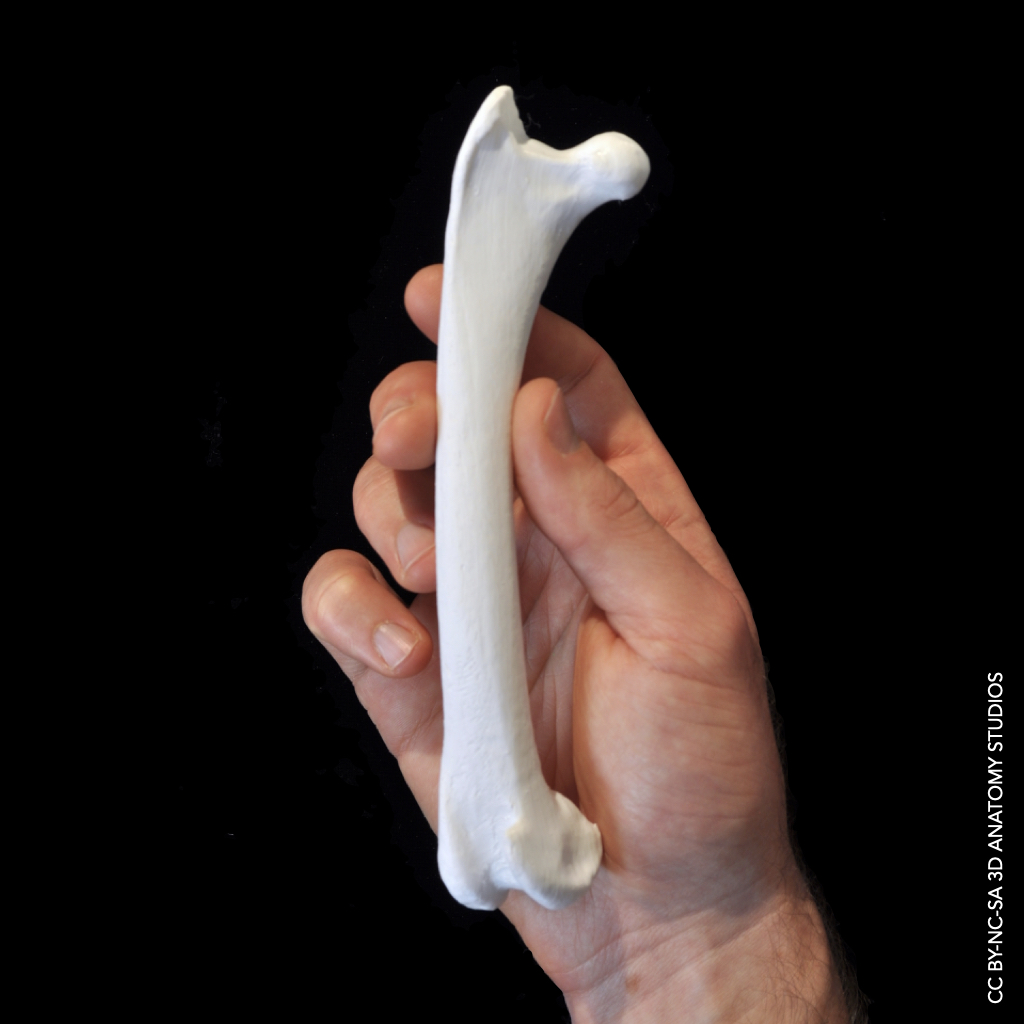
These services make use of the same resources that we use for the more start-up-like aspects of our business. For example, the 3D printers that we use to print custom 3D anatomical models or to create molds for casting silicone physical models are the same 3D printers that we use to prototype scalable products. And the code that we use to create interactive, digital anatomy models for custom websites is the same code that we’ve developed for use in our own digital products.
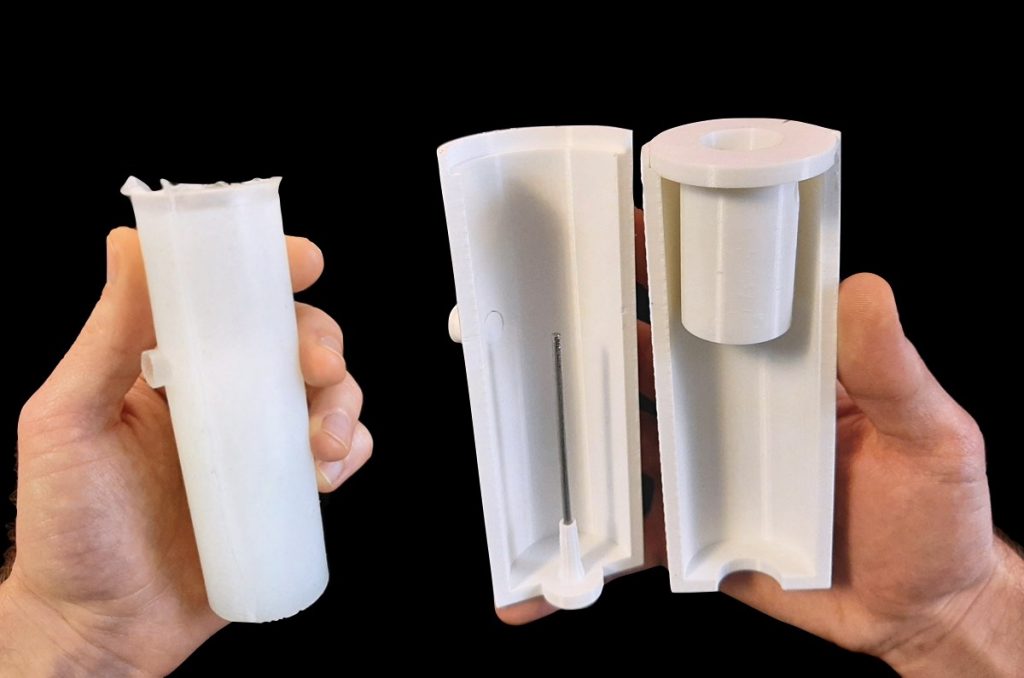
Also like a small business, we don’t have any outside investors. We’re a cooperative company, 100% owned and democratically governed by its members. And the primary way that our members invest in 3D Anatomy Studios is with their time, not with cash. So providing these services is not only a great way for us to apply our expertise to meet an unfilled need in the academic community, it is also a vital financial lifeline for us as we develop scalable products that will provide a more diversified and consistent source of revenue in the future.
Lastly, like a small business, we’re building 3D Anatomy Studios for the long haul, not for an exit. We’ve written an extensive, yet continuously evolving, member agreement that governs how we admit new members, make decisions, allocate income, and every other major aspect of running an organization. We’ve built our own website with an online shop so that we can sell our products directly to our customers, rather than through a third party. And we’re building every aspect of our business, from accounting to marketing, to conform with our principles of democratic ownership and control. Each of these has taken an enormous investment of time. But these are investments in 3D Anatomy Studios as an organization of passionate and dedicated individuals, rather than an investment in any particular business model, and demonstrate our commitment to operating as a small business in the long term.
How 3D Anatomy Studios is a start-up
While in many ways we operate like a small business, we’ve also borrowed certain elements from the lean start-up approach, particularly in how we develop new products and test out unproven business models. This approach is centered around the process of Customer Discovery. Customer Discovery starts from the premise that the most successful business models aren’t developed by one person or a team working in isolation in an office or lab. Rather, they are developed by “getting out of the building” and talking with, and more importantly listening to, actual (potential) customers. Entrepreneurs often make the mistake of spending months or years developing what they think will be the perfect product, without ever talking to a single customer, only to discover in the end that they’ve created a product no one wants to buy.
Customer discovery aims to reduce that risk by having the entrepreneur start not with product design but with customer interviews. During these interviews, the entrepreneur asks the interviewee to talk about their experience related to a product or service that the entrepreneur wants to develop, in particular the problems, challenges or frustrations that they felt. For example, our Java House entrepreneurs might ask, “tell me about the last time you went to a coffee shop.” They might then ask the interviewee something like, “Tell me about something that frustrated you last time you went to a coffee shop?” The goal of these interviews is to get interviewees to share the most fundamental problems or needs that they experience related to a particular product or service.
We are currently using customer discovery to develop better learning resources for anatomy and physiology (A&P). Last fall we started conducting customer discovery interviews via Zoom of professors who teach classes with either an anatomy or physiology component. In each interview, we ask the professor to tell us about their classes and then share the greatest challenges they face in their teaching. So far we’ve interviewed 40 professors at all types of institutions across the US.
Like a start-up, we’re using these interviews to inform the design of our first product and some of the most common challenges that we’ve heard from professors are things that we never would have anticipated. For example, many professors have reported frustration that students see their course as just a memorization class rather than a class about deeper or core concepts, such as form and function, evolution, or integration. The names of structures are easy to forget whereas concepts stick with students and are broadly applicable outside of anatomy. Professors want to make their courses more about concepts so that students achieve higher-order learning, retain more of what they learn, and engage more with the material.
Another frequently mentioned challenge that we didn’t anticipate is the lack of modularity in currently available resources. Professors expressed frustration that many currently available resources for A&P classes are intended to be the sole resource for the course. It’s either buy the whole package or nothing at all. Professors want to pick and choose different resources to create a class tailored to what they want to teach.
These are just a couple of the many challenges that we’ve compiled and now that we’ve collected a decent sample of challenges, we’re moving to the next stage of the lean start-up approach: developing a first product prototype and going back to the people we interviewed previously to test whether our prototype solves the problems that they mentioned. Even though we’ve done these interviews, we can’t assume that our first product design will necessarily solve their problems. The lean start-up approach uses iterative design and feedback between the entrepreneurs and potential customers to make sure that the product is designed according to the customer’s needs, not what the entrepreneurs think the customers need.
The A&P learning product we’re developing is unlike anything currently on the market and we think it will revolutionize A&P education. We’re really excited to share more about it here once we’ve gone through the iterative design-feedback stage. But just as for a start-up, we don’t know whether this new business model (e.g., how we’re planning to make, distribute, and sell the product) is viable. Is 3D Anatomy Studios an A&P educational resource product design company? We certainly hope that this represents a viable business model and we can say that in a few months time! At this time it’s simply a business model that we are actively testing out. However, we can certainly say that we are innovators in A&P education and that we are seeking to solve the most pressing challenges facing A&P educators that can be solved through educational resources.
So, what does 3D Anatomy Studios do?
So what do I say when people ask me, “What is 3D Anatomy Studios?” Until now, I typically say something like, “we’re a cooperative of scientists working at the intersection of anatomy and design.” Yes, it’s vague, but given the wide range of projects we are pursuing, it felt like the only quick response that came close to capturing what we represent. In some ways, we’re also still answering that question – that’s half the fun! Hopefully if this post hasn’t given a satisfactory answer to the question, it’s at least explained how we’re answering it.
But I think going forward, for now, I’ll respond that 3D Anatomy Studios is an innovation space for scientists and designers passionate about solving problems in organismal biology research, education, and outreach. Because that’s ultimately what we’re doing, whether through our professional services or in designing our first product. Solving problems iteratively, creatively, and cooperatively.
Edited by Callie Crawford
Illustration and photographs by Aaron Olsen


